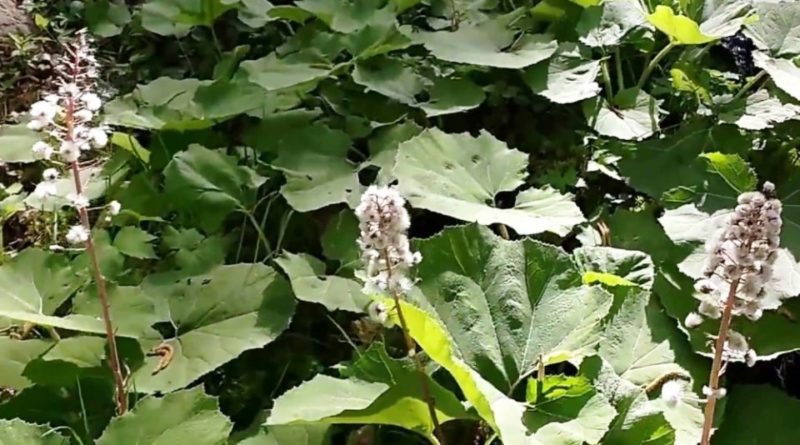Petasites hybridus
Petasites hybridus
The butterbur (Petasites hybridus (L.) G. Gaertn., B. Mey. & Scherb., 1801) is a herbaceous species belonging to the Asteraceae family.
Systematic –
From a systematic point of view, it belongs to the Eukaryota Domain, Kingdom Plantae, Superdivision Spermatophyta, Division Magnoliophyta, Class Magnoliopsida, Subclass Asteridae, Order Asterales, Family Asteraceae, Subfamily Asteroideae, Tribe Senecioneae, Subtribu Tussilagininae and therefore to the Genus P. Petites hybrid. .
The numerous synonyms with which this species has been classified are also reported:
– Petasites georgicus Mandenova (1947);
– Petasites giganteus Fuss (1866);
– Petasites major Cariot & St-Lager (1889);
– Petasites officinalis Moench;
– Petasites officinalis Moench proles reuterianus (Jordan) Rouy (1903);
– Petasites officinalis Moench subsp. foemina (Hayne) Wenderoth (1846);
– Petasites officinalis Moench var. hybridus (L.) P. Fourn. (1939);
– Petasites ovatus Hill (1756);
– Petasites pratensis Jordan (1852);
– Petasites reuterianus Jordan;
– Petasites riparius Boreau (1857);
– Petasites sabaudus Beauverd;
– Petasites vulgaris Desf. (1799);
– Tussilago hybrida L. (1753) (basionimo);
– Tussilago petasites Scop ..
Etymology –
The term Petasites comes from pétasus, in turn from the Greek πέτᾰσος petaso, large-brimmed hat: for large leaves.
The specific epithet hybridus means bastard, hybrid, cross: of species believed (rightly or wrongly) derived from crosses of different species, probably in reference to a possible hybrid origin of this species.
Geographical Distribution and Habitat –
The Butterbur is a plant of Eurasian origin with a diffusion in Europe, on the reliefs and in the following areas: Central Massif, Jura Massif, Vosges, Black Forest, Carpathians and Balkan Mountains. Outside Europe, it is located in northern and western Asia. It also grows in North America, but this species, like others, was probably accidentally introduced from Europe in the colonial period and therefore easily naturalized as an invasive plant.
In Italy this plant is common throughout the territory excluding the islands.
Its typical habitat is that of humid places, the banks and edges of streams, and in general the cool and shady but also gravelly and stony areas, where it grows preferably on preferred substrate both calcareous and siliceous with neutral pH, high nutritional values of the soil (it is in fact a nitrophilic species) which must be a little humid and at an altitude ranging from sea level up to 1650 m asl.
Description –
Petasites hybridus is a herbaceous plant with a very showy, hairy, geophyte and rhizomatous habit.
The basal leaves are large in size, with a diameter that in the summer can reach 120 cm in diameter, with a green leaf, more or less heart-shaped, indented margin, on a long and robust deeply grooved petiole; the cauline leaves are sessile, reduced to scales, red.
The flower heads are very numerous, carried by a 10-40 cm floral scape; the corolla is tubular, pinkish-white or red in color.
The antesis is between March and May.
The fruits are cipsele with 2-3 mm sub-cylindrical achene, furrowed, hairless and dominated by a thick pappus of long whitish, soft hairs that measure about 10 mm.
Cultivation –
The Butterbur is a spontaneous species that grows almost indifferently on calcareous or siliceous soils, provided that the pH tends towards neutral. This plant, being nitrophilic, can also become a pest in cultivated areas, especially if humid, where excessive nitrogen fertilizations are carried out so that it then becomes difficult to eliminate.
The collection period is however between May and June.
Uses and Traditions –
The butterbur, also known simply as butterbur or cabbage, is a spontaneous plant with wide diffusion.
A similar species with which it can be confused is the Petasites fragrans (butterbur vanilla), which is easily distinguished by its much smaller growth habit, maximum leaves 20 cm and flower heads of 5-10 cm.
Petasites hybridus is collected and consumed for food purposes. The parts used are the rhizomes, the flower heads and the leaves.
The leaves have the property of calming the cough, while instead just harvested they are applied on the ulcers to obtain a rapid healing.
Some active ingredients are contained within this plant such as: essential oils, glucoside, mucilage, tannins, and various mineral salts.
Precisely for these substances the plant has healing properties; in folk medicine it is used for their vulnerable properties (heals wounds), sedative (calms excess nervous or painful states), bechiche (calming action of cough), diaphoretic (facilitates skin perspiration), cardiotonic (regulates heart rate) and emmenagogues (regulates menstrual flow).
On the other hand, it is not used, if not rarely, in gardening because, as mentioned, this plant, under certain conditions, is quite invasive, occupying large areas.
Preparation method –
The Butterbur, as mentioned, is a plant that is also used in the kitchen. The parts used are the leaf stalks, young and tender leaves, to be eaten boiled: seasoned with oil and lemon, fried in batter, in omelette.
However, edible use is not recommended as this plant contains some hepatotoxic alkaloids (pyrrolizidine alkaloids).
Guido Bissanti
Sources
– Acta Plantarum – Flora of the Italian Regions.
– Wikipedia, the free encyclopedia.
– Treben M., 2000. Health from the Lord’s Pharmacy, Tips and experiences with medicinal herbs, Ennsthaler Editore
– Pignatti S., 1982. Flora of Italy, Edagricole, Bologna.
– Conti F., Abbate G., Alessandrini A., Blasi C. (edited by), 2005. An annotated checklist of the Italian vascular flora, Palombi Editore.
Warning: Pharmaceutical applications and alimurgical uses are indicated for information purposes only, they do not in any way represent a medical prescription; therefore, no responsibility is accepted for their use for healing, aesthetic or food purposes.


